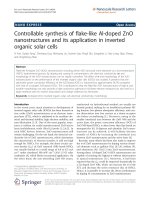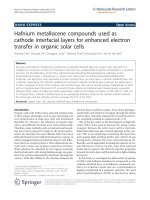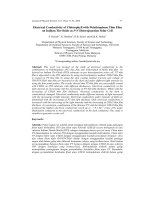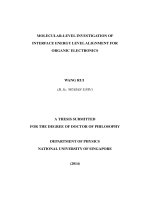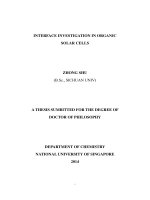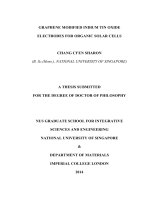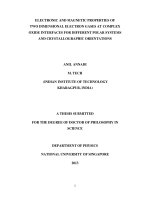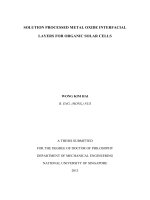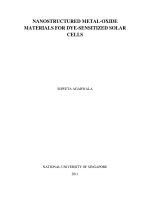Graphene modified indium tin oxide electrodes for organic solar cells
Bạn đang xem bản rút gọn của tài liệu. Xem và tải ngay bản đầy đủ của tài liệu tại đây (17.37 MB, 194 trang )
GRAPHENE MODIFIED INDIUM TIN OXIDE
ELECTRODES FOR ORGANIC SOLAR CELLS
CHANG CI’EN SHARON
(B. Sc.(Hons.), NATIONAL UNIVERSITY OF SINGAPORE)
A THESIS SUBMITTED
FOR THE DEGREE OF DOCTOR OF PHILOSOPHY
NUS GRADUATE SCHOOL FOR INTEGRATIVE
SCIENCES AND ENGINEERING
NATIONAL UNIVERSITY OF SINGAPORE
&
DEPARTMENT OF MATERIALS
IMPERIAL COLLEGE LONDON
2014
i
Declaration
I hereby declare that this thesis is my original work and it has been written by me in
its entirety. I have duly acknowledged all the sources of information which have
been used in the thesis.
This thesis has also not been submitted for any degree in any university previously.
___________________________
Chang Ci’En Sharon
28 July 2014
ii
Dedicated to my loving family and my partner
iii
Acknowledgement
Praise God from whom all blessings flow
These four years of PhD could not have been made possible without the help of many people who
rendered assistance at work, gave a listening year, or blessed me with their friendship and
prayers. To begin, I would like to express my gratitude towards my supervisors, Prof Andrew
Wee and Sandrine Heutz, for their invaluable support, advice and guidance that goes beyond the
sciences; for knowing when to push me to achieve more, and when to encourage a break to
refresh and take stock. Chen Wei and David McPhail, as part of my thesis advisory committee,
also provided timely feedback and useful discussions.
I would like to thank my colleagues past and present in the Surface Science Lab NUS, in Heutz’s
group in the ICL, and in the LCN office. Their friendship and aid, shared joys and grieves,
encouragement and small talks, helped me through the bleak parts of my PhD (and the bleak
London winter). I would like to specially thank Hendrik Glowatzki, Cao Liang, Wei Da Cheng,
Wang Rui, Luke Fleet and James Gilchrist who invested so much time and energy in imparting
experimental techniques and safety considerations; patiently discussed and analysed experimental
data; and even advising on the finer details such as the presentation of data. Their integrity and
rigor towards proper scientific methodology and data handling have left a lasting impression on
me. I am grateful to the assistance of Kendra Kam and Dr. Chua Lay Lay for the provision of
some of the samples for synchrotron measurements, to James for his partnership with all the solar
cell device work, and to Sarah Fearn for her expertise with all the TOF-SIMS measurements.
These people beyond the scope of work have also played an integral part in this process: Fish,
Nadia, Clarence, Jiahui, Cedric, Boredin, Valerie, Peggy, Ivy, Aunt Sau Har and the many others
iv
behind the scenes whom I cherish in my heart. I am deeply indebted to my loving family
throughout all these years who encouraged and prayed for me; who selflessly sacrificed their
time, energy, sleep and resources to walk this journey with me. Thank you for being my pillar of
support throughout all the years of my life, for being my best friends, and for making this dream
of graduate studies a reality. Finally, to my dearest Taffy, who embarked on life’s journey
together with me over the last five and a half years, thank you for loving, blessing, and waiting
for me.
v
List of Publications
Gilchrist, J. B., Basey-Fisher, T. H., Chang, S. C’ E.*, Scheltens, F., McComb, D. W. & Heutz, S.
Uncovering the Buried Interface in Molecular Photovoltaics. Adv. Funct. Mater. 24, 6473-6483
(2014).
Chang, S. C’ E.*, Fearn, S., McPhail, D., Wee, A. T. S. & Heutz, S. TOF-SIMS Investigation of
F4-TCNQ Diffusion Through CuPc Molecules. In preparation (2014).
Chang, S. C’ E.*, Liang, C., Gilchrist, J. B., Wei, C., Heutz, S. & Wee, A. T. S. Molecular
Modification of Graphene to Control the Structural and Electronic Properties of CuPc in Organic
Solar Cells. In preparation (2014).
Chang, S. C’ E.*, Liang, C., Wei, C., Heutz, S. & Wee, A. T. S. Thin Film Properties of F
4
-
TCNQ as an Interface Dopant on ITO and Graphene Modified ITO. In preparation (2014).
vi
Table of Contents
Summary x
List of Tables xii
List of Figures xiii
List of Abbreviations xx
Chapter 1 : Introduction 1
1.1 Organic Photovoltaics Devices 1
1.1.1 Basic Properties of OPV Devices 2
1.1.2 Structural Templating in OPV Devices 4
1.1.3 Energy Level Alignment in OPV Devices 7
1.2 Structural Properties of CuPc 10
1.3 Thesis Overview 11
1.4 References 14
Chapter 2 : Experimental Methodology 1
2.1 The OMBD Growth System 21
2.2 Characterization Techniques 23
2.2.1 Working Principle of PES Measurements 23
2.2.2 NEXAFS Measurements 27
2.2.2.1 Experimental 30
2.2.3 Time-of-Flight Secondary Ion Mass Spectrometry Working Principles 31
2.2.3.1 Experimental 33
2.2.4 X-ray Diffraction 35
2.2.4.1 Experimental 36
2.2.5 Atomic Force Microscopy 37
2.2.5.1 Experimental 38
vii
2.2.6 Scanning Electron Microscopy 38
2.2.6.1 Experimental 39
2.2.7 Ultraviolet-Visible Spectroscopy 39
2.2.7.1 Experimental 40
2.2.8 Current-Voltage Characterization 40
2.2.8.1 Experimental 42
2.3 Sample Preparation 42
2.3.1 Sample Cleaning 42
2.3.2 Transfer of Graphene to ITO 43
2.3.2.1 Characterization of Graphene Films 44
2.3.3 Thin Film Deposition 47
2.4 References 49
Chapter 3 : Controlling the Molecular Orientation of CuPc Using Graphene Interlayer on ITO 52
3.1 Introduction 52
3.2 Energetic Properties of CuPc on ITO and G/ITO 53
3.3 Molecular Orientation of CuPc on ITO and G/ITO 63
3.4 OPV Device Characterization using ITO and G/ITO as Anode Layer 69
3.5 Conclusion and Future Work 73
3.6 References 74
Chapter 4 : F
4
-TCNQ Thin Film Properties 80
4.1 Introduction 80
4.2 Calibration of F
4
-TCNQ Film Thickness 82
4.3 Electronic Structure of F
4
-TCNQ on ITO and G/ITO 84
4.4 Structural Analysis of F
4
-TCNQ on ITO and G/ITO 91
4.5 Conclusion 98
4.6 References 99
Chapter 5 : Modification of ITO and G/ITO Anodes with F
4
-TCNQ 104
viii
5.1 Introduction 104
5.2 Structural Properties of CuPc 105
5.2.1 CuPc Deposited on F
4
-TCNQ Pre-covered G/Cu and Cu 105
5.2.2 CuPc Deposited on F
4
-TCNQ Pre-covered Si & G/Si, and ITO & G/ITO 108
5.3 Optical Absorption of CuPc on F
4
-TCNQ Pre-Covered ITO and G/ITO 114
5.4 Interfacial Energetics of CuPc on F
4
-TCNQ Pre-Covered ITO and G/ITO 117
5.6 Device Characterization of OPV 128
5.7 Conclusion and Outlook 132
5.8 References 134
Chapter 6 : Diffusion of F
4
-TCNQ Molecules 138
6.1 Introduction 138
6.2 Diffusion of Interface F
4
-TCNQ into Bulk CuPc Film Deposited on ITO, G/ITO and G/Cu
140
6.2.1 Influence of CuPc Molecular Packing on F
4
-TCNQ Diffusion Dynamics 143
6.2.2 Effect of Interfacial Interaction on F
4
-TCNQ Diffusion 147
6.2.3 Diffusion of F
4
-TCNQ through CuPc Deposited on ITO versus G/ITO 150
6.3 Co-deposition of F
4
-TCNQ and CuPc as a Method to Estimate Dopant Diffusion 152
6.3.1 Preparation of Co-deposited Films 152
6.3.2 F
-
Profiles for Co-Deposited Samples 153
6.4 Conclusion and Outlook 156
6.5 References 158
Chapter 7 : Thesis Summary 161
7.1 Thesis Summary 161
7.2 Future Work 164
7.3 References 165
Appendix A – Characterization of G/Si 166
Appendix B – Solar Cell Data 167
ix
Appendix C – Edge Angles of F
4
-TCNQ Crystallites 168
Appendix D – Depth Resolution for TOF-SIMS 169
Appendix E – TOF-SIMS Depth Profile of ITO 170
Appendix F – TOF-SIMS Depth Profile of 6.5mol% F
4
-TCNQ Co-deposited with CuPc 171
x
Summary
In this thesis, we explore the use of graphene incorporated onto indium tin oxide (G/ITO) as a
structural template to modify the orientation of copper phthalocyanine (CuPc) molecules for
organic photovoltaic (OPV) device applications. We also investigate the effectiveness of 2,3,5,6-
tetrafluoro-7,7,8,8-tetracyanoquinodimethane (F
4
-TCNQ) as a work function modifier for G/ITO
without compromising the templating properties of graphene. Photoemission spectroscopy (PES)
is employed to assess the electronic properties at the anode-CuPc interface, while X-ray
diffraction (XRD) and near-edge X-ray absorption fine structure (NEXAFS) are used to
determine the molecular orientation of CuPc. OPV devices are fabricated to attempt to correlate
the observations at the microscopic level with the macroscopic device performance.
First, we investigate the electronic properties of CuPc deposited on G/ITO and ITO using PES.
While the interaction between CuPc molecules and ITO and G/ITO is similar, the hole injection
barrier (HIB) is ~0.9 eV for CuPc/G/ITO as compared to 0.5 eV for CuPc/ITO. Therefore, further
modification of G/ITO to reduce the HIB is required. The XRD spectrum of CuPc molecules
deposited onto graphene grown on copper foil (G/Cu) verifies that graphene is an effective
structural template, causing CuPc molecules to ‘lie’ on the substrate. NEXAFS data shows that
the orientation of CuPc molecules changes from ‘standing’ on ITO to ‘tilted’ on G/ITO.
Next, the effectiveness of F
4
-TCNQ deposited on ITO and G/ITO as a work function modifier is
assessed. A thin layer of F
4
-TCNQ is able to increase the substrate work function to ~5 eV, which
is close to the ionization potential of CuPc molecules. This suggests that barrierless extraction of
holes from CuPc into F
4
-TCNQ modified ITO or G/ITO may be possible. F
4
-TCNQ molecules
are found to be predominantly tilted on G/ITO, suggesting that the templating property of
graphene may be propagated through F
4
-TCNQ molecules. CuPc molecules deposited onto F
4
-
TCNQ/G/ITO attain a ‘lying’ configuration, confirming that the templating property of graphene
xi
is preserved despite the inclusion of a layer of F
4
-TCNQ. The HIB is dramatically reduced to ~0.2
eV for CuPc/F
4
-TCNQ/G/ITO, and ~0.1
eV for CuPc/F
4
-TCNQ/ITO. Optical absorption of
templated CuPc molecules over the visible range is enhanced by over 40% as compared to the
non-templated molecules. Therefore, the structure of F
4
-TCNQ/G/ITO appears to be a potential
anode design to improve OPV device performance. Our test cells however do not show an
improvement in OPV parameters due to the poor quality of transferred graphene, and the high
series resistance in our unoptimized OPV device.
Finally, the diffusion of F
4
-TCNQ through a CuPc film is studied using time-of-flight secondary
ion mass spectrometry (TOF-SIMS). The F
-
depth profiles establish that a higher quantity of F
4
-
TCNQ molecules diffuse into CuPc on the G/ITO sample. This is attributed to the weaker
interfacial adhesion between F
4
-TCNQ and graphene, and the crystallinity of the templated CuPc
film. The quantity of diffused F
4
-TCNQ in the G/ITO sample is only about 0.2 mol%. At this
dopant concentration, the conductivity of the film should increase; thus doping of the whole
organic film may be favourable for OPV devices.
xii
List of Tables
Table 2-1 Growth rates and deposition temperatures of the various materials used in this thesis.
The growth rate of Al was 0.2 Å/s for the first 20 nm deposited directly on the organic materials
to minimize sample damage by the hot Al molecules, but increased to 0.5 Å/s for the next 80 nm.
49
Table 4-1 Summary of the peak intensities of the (2 1 1) and (0 2 0) in the F
4
-TCNQ/ITO and F
4
-
TCNQ /G/ITO films, as well as F
4
-TCNQ powder diffraction. 96
xiii
List of Figures
Figure 1-1 A schematic drawing showing the typical layers in an OPV device. The materials used
in this dissertation are annotated in the diagram; for the intermediate layers, the front layer is
graphene and F
4
-TCNQ, and the back layer is BCP. A planar heterojunction is shown for
simplicity. Light enters the cell from the anode side. 3
Figure 1-2 Schematic drawings showing the effect of structural templating on planar molecules.
Individual molecules are shown and the direction of the stacking axis is indicated by the dashed
arrow. (a) ‘Standing’ orientation of the molecules before templating, and (b) the ‘lying’
orientation with the inclusion of a template layer. 5
Figure 1-3 Schematic drawing showing the energy levels in an OPV. E
ex
and E
b
refer to the
Coulombically bound exciton energy and exciton binding energy respectively. The HOMO and
LUMO positions of the donor (subscript D) and acceptor (subscript A) materials, and the HIB are
also shown. The dashed arrows in the donor and acceptor bands indicate the directions of the hole
and electron diffusion respectively. 8
Figure 1-4 (a) Chemical structure of a CuPc molecule. The structure consists of carbon atoms
(grey), nitrogen atoms (blue) and a central Cu (red). (b) Geometric illustration of a CuPc column,
and (c) a brick-stack arrangement of the one-dimensional CuPc column as proposed by
Hoshino.
86
The grey shaded area in (c) represents a 2-dimensional unit cell. 10
Figure 1-5 Flow chart showing the key systems and experimental investigations in each chapter,
and cohesion between the chapters 14
Figure 2-1 (a) Experimental setup of an OMBD system with a glove box. The positions of the
sample holder and organic sources within the OMBD chamber are shown by the dashed boxes
marked (b) and (c) respectively. Images of (b) the sample holder and (c) several sources for
organic materials. A QCM is highlighted in (c). Figures (b) and (c) are obtained from the Kurt J.
Lesker website.
29
22
Figure 2-2 (a) Energy level alignment between the sample and analyser when they are in good
electrical contact. (b) A typical UPS spectrum of organic molecular thin films. 25
Figure 2-3 ‘Universal curve’ showing the typical electron escape depth (attenuation length) in
monolayers as a function of the electron kinetic energy. Reproduced from Reference [2]. 27
Figure 2-4 Polarization dependent NEXAFS spectra showing the ability of this technique to
differentiate different orientations of the chemical bonds. For a molecule lying flat on a substrate,
the σ* transitions are maximized at normal incidence to the substrate (θ = 90
o
) (a), while π*
transitions are maximised at grazing incidence (θ = 20
o
) (b). 28
Figure 2-5 Schematic drawing showing a typical PES experimental setup, specifically for XPS in
this example. For UPS, the incident beam is changed to ultraviolet light. Reproduced from
Reference [28] 31
xiv
Figure 2-6 Schematics showing (a) the main instrumental layout, and (b) the timescales of the
analysis and sputter guns, and the detection of the secondary ions in dual-beam interlace mode.
Reproduced from Reference [27]. 33
Figure 2-7 A schematic drawing showing X-ray diffraction from a crystal lattice. The X-ray
beam is depicted as the black solid lines and forms an angle θ with the sample. The blue circles
are scattering centres and the interplanar lattice spacing is d. 36
Figure 2-8 Schematic drawing of a basic AFM setup. 37
Figure 2-9 A typical J-V response curve for a solar cell device under illumination. J
sc
is measured
the external voltage is 0 V; V
oc
corresponds to the point where the drift current in a solar cell is
balanced by the diffusion current. 41
Figure 2-10 (a) Top view of the solar cell device chamber used in the experiment. (b) The solar
cell device chamber is interfaced with a switch box that allows for independent measurement up
to six solar cell devices fabricated on a single substrate. 42
Figure 2-11 Average Raman spectrum of as-received G/Cu foil (top) and transferred G/ITO
(bottom) after subtracting their baseline, using 514 nm laser excitation. The characteristic 2D and
G peaks of graphene, and the defect induced D peak are shown. The peak at ~2330 cm
-1
in the top
spectrum comes from the Raman mode of N
2
gas.
26
45
Figure 2-12 SEM images of (a) G/Cu (x5000 magnification), and (b) and (c) G/ITO at two
different areas (x3000 magnification). (a) Bright contrast areas and spots correspond to holes in
the as-grown graphene and residues respectively; (b) bright streaks and spots correspond to
wrinkles and residues respectively; (c) brighter areas are due to tears in the graphene sheet, thus
revealing the underlying substrate. Scale bars are 5 m for all the images 46
Figure 2-13 1 µm x 1 µm AFM images of (a) bare ITO in plane view and (b) 3-dimensional
view, and (c) G/ITO with the central area devoid of graphene to show the contrast in surface
features. (d) Line profiles of the solid and dashed line in (c) indicate that while the variation in z-
height is similar on G/ITO and ITO, the surface features become indistinct. RMS surface
roughness is (a) 5.0 nm, and (c) 4.0 nm excluding the bright feature and the uncovered region. . 47
Figure 3-1 Synchrotron based PES spectra evolution of CuPc on ITO. (a) Low kinetic energy
region, (b) valence band spectra at low binding energy and (c) near the Fermi level region. The
thickness of the CuPc film in (a) – (c) is denoted as θ
CuPc
and increases from (i) 1 Å to (vi) 100 Å.
The peak position in (b) indicated by ‘ * ’ is formed by the overlap between the HOMO-4 and
HOMO-5 orbitals of CuPc;
27
their respective intensities depend on orientation of the molecules.
The arrow in (b) marks another spectra feature (HOMO-1) of CuPc that depends on molecular
orientation 54
Figure 3-2 C 1s core level spectra for different film thicknesses of CuPc deposited on ITO.
Dashed black lines represent the signal originating from the substrate, whereas the solid orange
lines are attributed to CuPc. 57
Figure 3-3 Synchrotron based PES spectra evolution of CuPc deposited on G/ITO. (a) Secondary
electron cutoff region at low kinetic energy, (b) valence band spectra at low binding energy and
(c) near the Fermi level region. ‘ * ’ in (b) corresponds to the same symbol in Figure 3-1(b). 59
xv
Figure 3-4 C 1s core level spectra CuPc deposited on G/ITO. Dashed black lines represent the
signal originating from the substrate, whereas the solid orange lines are attributed to CuPc. 60
Figure 3-5 Schematic drawings showing the energy level diagrams of CuPc deposited on (a) ITO
and (b) G/ITO. The work function, HIB and IP values are derived from PES measurements while
the transport gap (2.20 eV) which defines the position of the LUMO is obtained from literature.
24
The position of E
F
is denoted by the blue dashed line, while the HOMO and LUMO positions are
represented by the pink and blue bands respectively. 61
Figure 3-6 (a) XRD spectra of (blue spectrum) CuPc powder showing all possible diffractions
from α-CuPc crystals (scaled for clarity), (black) 30 nm CuPc deposited on 20 nm PTCDA pre-
covered ITO, (green) 100 nm CuPc on G/Cu and (red) 100 nm CuPc/Cu. The dashed grey line
indicates the diffraction peak at 27.6
o
. (b) Close-up spectrum of the diffraction peaks of the 100
nm CuPc/G/Cu sample showing details of the fitted peaks (in black). These peaks correspond to
the (01-2) and (11-2) planes at 26.6
o
and 27.6
o
respectively for α-CuPc. Schematic drawings
showing (c) the angle α between the molecule and the substrate, (d) the ‘lying orientation’ on
PTCDA or graphene covered substrates, and (e) the ‘standing’ molecular orientation of CuPc on
weakly interacting substrates such as ITO. 64
Figure 3-7 (a) Schematic diagram defining the incident beam angle θ in a NEXAFS setup. (b)
Illustration showing graphene transferred onto ITO and the relative the size of the incident photon
beam (8 mm x 1 mm) at θ = 20
o
(grazing incidence). At this angle the beam is larger than the
graphene sheet, therefore the calculated CuPc molecular angle is an average of graphene covered
areas and the bare substrate. Graphene sheet also tears during the transfer process and forms holes
which reveal the underlying substrate. The sizes of the holes are exaggerated for clarity. Angle-
dependent NEXAFS N K-edge spectra for 10Å and 100Å CuPc deposited on (c) ITO and (d)
G/ITO at θ = 90
o
(red) and θ = 20
o
(black). 67
Figure 3-8 (a) Schematic diagram of the solar cell structure used in all solar cell characterization
experiment. ‘ A ’ refers to the structure 100 nm Al/12 nm BCP/40 nm C
60
/30 nm CuPc while the
intermediate layer is either 5 nm PTCDA or graphene in this chapter; 5 Å F
4
-TCNQ or 5 Å F
4
-
TCNQ/graphene in Chapter 6; or entirely absent. (b) Top view drawing of G/ITO solar cell with
Al top contacts (8.0 mm x 0.15 mm) in blue. The contacts overlap areas where graphene has torn
and the underlying ITO substrate is revealed. Current density as a function of cell voltage (J-V)
curves under 100 mW/cm
2
illumination for (c) red: A/ITO & black: A/5nm PTCDA/ITO, and (d)
red: A/ITO & black: A/G/ITO. Inset: J-V curve of the devices under dark. Current leakage is very
pronounced for the substrate modified by graphene interlayer in (c). 71
Figure 4-1 (a) Chemical structure of F
4
-TCNQ. UV-Vis absorbance spectra as a function of
versus wavelength for (b) varying concentrations of powdered F
4
-TCNQ dissolved in DCM and
(c) 80 nm nominal thickness F
4
-TCNQ deposited on glass and dissolved in DCM. Inset in (b):
Plot of best fit line for the integrated area of the main peak (i) of F
4
-TCNQ absorbance spectra
(centred at 391 nm) as a function F
4
-TCNQ concentration. Position of the red marker on the line
(highlighted by an arrow) indicates the integrated area of the major peak of the dissolve film in
(c). 83
Figure 4-2 UPS spectra evolution of F
4
-TCNQ deposited onto ITO. (a) UPS spectra at low
kinetic energy region, and (b) plot of sample work function with increasing F
4
-TCNQ thickness.
(c) Valence band spectra at low binding energy and (d) near the Fermi level region of spectra
from (c). θ
F4-TCNQ
refers to the thickness of the F
4
-TCNQ film. 85
xvi
Figure 4-3 (a) PES spectra of F
4
-TCNQ on ITO at low binding energy near the Fermi level
measured with 60 eV synchrotron radiation. Distinct charge transfer features centred around 0.6
eV and 1.6 eV below the Fermi level are visible at this photon energy. (b) Fitted charge transfer
peaks from the 5Å F
4
-TCNQ spectrum in (a) following subtraction of the substrate signal. 87
Figure 4-4 UPS spectra evolution of F
4
-TCNQ deposited on graphene transferred onto ITO
(G/ITO). (a) Spectra at low kinetic energy region, (b) plot of sample work function against F
4
-
TCNQ thickness. (c) Valence band spectra at low binding energy and (d) near the Fermi level.
The characteristic 2p π feature of graphene at about 3.2 eV below Fermi level is circled in (d).
Inset in (d) shows the high resolution spectra of 1 Å F
4
-TCNQ/G/ITO (green) and G/ITO (black)
obtained using 60 eV synchrotron radiation. All other spectra were measured with photon energy
of 21.2 eV. 89
Figure 4-5 SEM images of 50 nm F
4
-TCNQ on (a) & (c) ITO and (b) & (d) G/ITO imaged at (top
row) x10000 and (bottom row) x50000 magnification. Higher surface coverage of ITO by F
4
-
TCNQ as compared to G/ITO indicates better wettability of F
4
-TCNQ on ITO. Scale bars are (a)
& (b) 2 µm and (c) & (d) 1 µm respectively. 91
Figure 4-6 Angle dependent NEXAFS N K-edge spectra for 10Å F
4
-TCNQ on (a) ITO and (b)
G/ITO, with α = 44
o
± 5
o
and α = 36
o
± 5
o
respectively. Peaks (i) – (iii) corresponds to resonant
transitions to the π* orbitals. (c) XRD pattern of F
4
-TCNQ thin film on (top, red) ITO and
(bottom, green) G/ITO. ‘#’ denotes the peak derived from ITO substrate. The diffraction peak
~19
o
in (c) corresponds to the overlap of the (2 1 1) plane at 18.8
o
and (0 2 0) plane at 19.0
o
. The
fitted peaks (black) are shown in (d) for ITO and (e) for G/ITO. 93
Figure 4-7 Schematic drawings showing the molecular orientations of F
4
-TCNQ with (a) the (2 1
1) plane parallel to ITO and (b) the (0 2 0) plane parallel to the ITO. The angles that the
molecules make with the plane are detailed in the images. The unit cell axes are shown as red for
the a-axis, green for b-axis and blue for c-axis. The c-axis in (b) projects into the plane of the
paper. 94
Figure 4-8 4 m x 4 m AFM images of (a) 50 nm F
4
-TCNQ/ITO and (b) F
4
-TCNQ/G/ITO. The
angles that the crystal edge makes with the substrate were extracted from the line profiles (an
example given in (c)) drawn across and perpendicular to the edge of the crystal as shown by the
yellow dashed lines in the images. The average angles are (a) 45
o
and (b) 63
o
averaged over 70
measurements each. 97
Figure 5-1 XRD spectra of CuPc deposited on various substrates to confirm that the templating
effect of graphene is unaffected by the inclusion of 5 Å F
4
-TCNQ. (a) Wide scan spectra of 100
nm CuPc/G/Cu (top) and 100 nm CuPc/5 Å F
4
-TCNQ/G/Cu (middle) show similar diffraction
peaks; 100 nm CuPc/5 Å F
4
-TCNQ/Cu (bottom) indicates that the change in orientation of CuPc
arises from the graphene interlayer. (b) & (c) Details of the fitted diffraction peaks for 100 nm
CuPc/5 Å F
4
-TCNQ/G/Cu and 100 nm CuPc/5 Å F
4
-TCNQ/Cu respectively. 107
Figure 5-2 XRD spectra of 30 nm and 100 nm CuPc on 5 Å F
4
-TCNQ pre-covered (a) Si and
G/Si, (b) ITO and G/ITO, to show the effectiveness of transferred graphene as a structural
template. Templated α-CuPc diffraction peak at ~27
o
is present on all graphene modified surfaces
except 30 nm CuPc/5 Å F
4
-TCNQ/G/ITO. The presence of this feature on G/Si in (a) at the same
molecular coverage indicates that the rough ITO surface results in a greater distribution of crystal
orientation, resulting in weak diffraction intensity. All spectra show a diffraction peak centered
xvii
~6.8
o
as the incident beam is significantly larger than the graphene modified area at all 2θ angles,
hence diffraction from the unmodified areas are also detected. ‘ # ’ denotes diffraction peaks
originating from the ITO substrate and ‘^’ from the Si substrate. 109
Figure 5-3 500 nm x 500 nm AFM images of (a) 30 nm and (b) 100 nm thick CuPc/5 Å F
4
-
TCNQ/G/Si showing the larger crystallite size with thicker films. The average grain size is
approximately (a) 30 nm ± 5 nm and (b) 42 nm ± 7 nm. The RMS roughness is (a) 3.6 nm and (b)
6.2 nm respectively. 110
Figure 5-4 High resolution TEM images of 100 nm Al/12 nm BCP/40 nm C
60
/30 nm CuPc on (a)
Si and (b) ITO. Lattice fringes of CuPc are clearly visible on Si but not as distinct on ITO. (c) and
(d): Details of the CuPc (1 0 0) fringes with lattice spacing of 1.3 nm on Si and ITO respectively.
Greater spread of orientation of the fringes in (d) is due to substrate roughness. Scale bars are 20
nm for (a) and (b), 5 nm for(c) and (d). Images taken by James Gilchrist. 112
Figure 5-5 Angle dependent NEXAFS N K-edge spectra for 10 Å (top) and 100 Å (bottom) CuPc
deposited on 5 Å F
4
-TCNQ pre-covered (a) ITO and (b) G/ITO. The F
4
-TCNQ N K-edge signals
have been subtracted and only the spectra of CuPc films are shown. The angle that the molecular
plane makes with the substrate is (a) α = 72
o
± 5
o
and (b) α = 51
o
± 5
o
at both low and high CuPc
molecular coverages. 113
Figure 5-6 (a) (left axis) UV-Vis spectra of absorbance versus wavelength for 30 nm CuPc on 5
Å F
4
-TCNQ pre-covered ITO and G/ITO substrates and graphene; (right axis) the difference in
absorbance between the two samples. (b) Maximum light absorption occurs when the electric
field vector of the incident light (ࡱ) and transition moment of the molecule (ࡹ) are parallel 115
Figure 5-7 Synchrotron based PES spectra evolution of CuPc on 5 Å F
4
-TCNQ pre-covered ITO.
‘ 0
+
’ denotes 5 Å F
4
-TCNQ pre-covered ITO. (a) Low kinetic energy region, (b) valence band
spectra at low binding energy and (c) near the Fermi level region. ‘ * ’ in (b) shows orientation
dependence as is the case for Figure 3-1 (b). (d) Plot of 1 Å CuPc/5 Å F
4
-TCNQ/ITO, after
subtracting the background signal, shows that CuPc HOMO extends to the Fermi edge at this
molecular thickness. (e) Plot of work function (Φ), energy of the HOMO onset and HOMO peak
positions with respect to the Fermi level at 0 eV as a function of CuPc thickness. 118
Figure 5-8 Synchrotron based PES spectra evolution of CuPc on 5 Å F
4
-TCNQ pre-covered
G/ITO. 5 Å F
4
-TCNQ pre-covered substrate is denoted ‘ 0
+
’ (a) Low kinetic energy region, (b)
valence band spectra at low binding energy and (c) near the Fermi level region. ‘ * ’ in (b) has the
same meaning as in Figure 3-3 (b). (d) 1 Å CuPc/5 Å F
4
-TCNQ/G/ITO spectra near the Fermi
level after background subtraction showing a broad asymmetrical HOMO feature, and a feature
marked by an arrow that neither originates from neutral CuPc or F
4
-TCNQ. (e) Plot of work
function (Φ), energy of the HOMO onset and HOMO peak positions as a function of CuPc
thickness. 123
Figure 5-9 Energy level diagrams for CuPc on pre-covered F
4
-TCNQ on (a) ITO and (b) G/ITO.
The direction of hole extraction in an organic solar cell is indicated by the horizontal arrow in (a)
on the HOMO onset band (pink). The magnitudes of the band bending (BB), work function and
HIB are shown. The position of the LUMO (blue band) is obtained from literature.
41
(b)
Uncertainty in the HOMO (and correspondingly LUMO) onset position at low CuPc coverage is
marked by the dashed boxes. 125
xviii
Figure 5-10 (a) 1 µm x 1 µm and (c) 500 nm x 500 nm topographic AFM images of 30 nm
CuPc/5 Å F
4
-TCNQ/ITO. (b) & (d) is similar to (a) & (c) respectively but for 30 nm CuPc/5 Å
F
4
-TCNQ/G/ITO. Insets in (c) and (d) show line profiles across the image. The RMS roughness
(a) 5.5 nm, (b) 5.4 nm, (c) 5.1 nm and (d) 5.0 nm. [The high islands in (b) were excluded during
RMS calculations]. Height (z-axis) scale bar is shown besides each image. 126
Figure 5-11 (a) and (b) SEM images of 30nm CuPc/5Å F
4
-TCNQ/G/ITO at x1000 and x100000
respectively. Scale bars are (a) 2 µm and (b) 200 nm. The purple loop encloses an area where
graphene is absent due to the tearing of graphene during transfer, i.e. CuPc and F
4
-TCNQ are
grown directly on ITO. (b) Corresponding magnified image of the area marked in (a) showing the
scrolling of graphene and subsequent deposition of CuPc and F
4
-TCNQ at the ‘damaged’
interface. (c) 1 µm x 1 µm AFM image of CuPc/5 Å F
4
-TCNQ/G/ ITO near a ‘damaged’ interface
as described in (a) & (b). Black surface line profile indicates height variations of up to 30 nm at
certain areas (d). 128
Figure 5-12 Current density as a function of cell voltage (J-V) curves under (a) dark and (b) 100
mW/cm
2
illumination for red: A/5 Å F
4
-TCNQ/ITO and black: A/5 Å F
4
-TCNQ/G/ITO.
Graphene device shows large current leakage and poorer performance as compared to the device
without graphene. 131
Figure 6-1 (a) Representative raw data plot of negative secondary ion counts as a function of
sputter time (bottom axis) and crater depth (top axis) for 100 nm CuPc/5 Å F
4
-TCNQ/ITO fully
diffused sample. The grey shaded areas mark the region where the detector is saturated by ion
counts. CH
-
fragment shows significantly high and very stable counts for all the measured
samples, hence the F
-
counts will be normalized to the respective CH
-
counts in each
measurement. (b) Schematic diagram showing the direction of sputter as indicated with a bold
arrow. 142
Figure 6-2 Intensity of F
-
counts as a function of depth, with x = 0 nm referring to the exposed
CuPc surface. (a) ‘Control’ samples without F
4
-TCNQ to determine the concentration of F
-
present at the substrate interface and in CuPc. (b) – (d) 100 nm CuPc/5 Å F
4
-TCNQ on (b) G/Cu,
(c) G/ITO and (d) ITO. ‘Fresh’ samples which were measured immediately after deposition are
compared against similar samples that were measured one month after deposition (‘diffused’
samples), thus allowing the fluorine containing molecules to be fully diffused in the CuPc matrix.
(c) and (d) are plotted on the same y-scale for ease of comparison. 145
Figure 6-3 Curve fitting (black curve) for the various F
-
profiles for 100nm CuPc/5 Å F
4
-TCNQ
on (a) G/Cu, (b) G/ITO and (c) ITO. The (half) Gaussian curve fitting does not fit the profiles of
(a) and (c) well between x = 60 – 80nm as shown by the yellow shaded area. 148
Figure 6-4 Schematic drawing showing F
4
-TCNQ molecules at different distances from the
substrate. F
4
-TCNQ molecules are tightly bound at the substrate interface, and fully diffused in
the bulk CuPc film. On G/ Cu and ITO substrates, there may be an intermediate region, shown by
the dashed outline, where F
4
-TCNQ molecules are weakly bound 149
Figure 6-5 F
-
depth profiles for fully diffused samples on ITO (blue circles) and G/ITO (purple
triangle) respectively. 150
Figure 6-6 (a) Plot of deposition rate as a function of deposition time for F
4
-TCNQ molecules in
a CuPc matrix. (b) F
-
profile of co-deposited sample consisting of 11 mol% F
4
-TCNQ : 89 mol%
xix
CuPc measured after (green) 1 month, (blue) 4 months. The dashed pink line is the expected F
-
profile for uniform diffusion. The region of the graph between the arrows marked in (a) and (b)
identify that the variation in F- intensity with depth in (b) is related to the deposition rate of the
F
4
-TCNQ in the CuPc matrix. 154
xx
List of Abbreviations
AFM Atomic Force Microscopy
Al Aluminium
BCP Bathocuproine
BE Binding Energy
Bi Bismuth
C
60
Fullerene
Cs Caesium
CuPc Copper Phthalocyanine
D/A Donor-Acceptor Interface
DOS Density of States
E
F
Fermi Level
F
4
-TCNQ 2,3,5,6-Tetrafluoro-7,7,8,8-tetracyanoquinodimethane
FF Fill Factor
G/ITO Graphene modified Indium Tin Oxide deposited on Glass
G/Cu Graphene grown on Copper foil
G/Si Graphene modified Silicon
HOMO Highest Occupied Molecular Orbital
HIB Hole Injection Barrier
xxi
IP Ionization Potential
ITO Indium Tin Oxide deposited on Glass
J
sc
Short Circuit Current
KE Kinetic Energy
LUMO Lowest Occupied Molecular Orbital
NEXAFS Near-Edge X-ray Absorption Fine Structure
OMBD Organic Molecular Beam Deposition
OPV Organic Photovoltaic
OSC Organic Semiconductors
PES Photoemission Spectroscopy
PTCDA Perylene-3,4,9,10-tetracarboxylic dianhydride
QCM Quartz Crystal Microbalance
RMS Root Mean Square
R
S
Series Resistance
R
sh
Shunt Resistance
SEM Scanning Electron Microscopy
Si Silicon
TC
hkl
Texture Coefficient of the (h k l) plane
TEM Transmission Electron Microscopy
TOF-SIMS Time-of-Flight Secondary Ion Mass Spectrometry
xxii
UPS Ultraviolet Photoelectron Spectroscopy
UV-Vis Ultraviolet-Visible
V
oc
Open Circuit Voltage
XPS X-ray Photoelectron Spectroscopy
XRD X-Ray Diffraction
α Angle between the molecular and substrate planes
θ Angle between the incident beam and substrate plane
Φ Work function
θ
CuPc
(Å) CuPc film thickness in Å
θ
F4-TCNQ
(Å) F
4
-TCNQ film thickness Å
1
Chapter 1 : Introduction
This chapter serves to provide an overview of the key areas relevant to this thesis. To begin with,
an introduction to organic solar cells and its basic working principles will be briefly presented.
Following which, structural templating as a method to control the molecular orientation of the
donor molecules, and the importance of energy level alignment in an organic solar cell will be
discussed to provide a background for the work in this dissertation. Lastly, the structure of copper
phthalocyanine (CuPc) molecules, which will be used extensively in this investigation, will be
described.
1.1 Organic Photovoltaics Devices
The harvesting of energy directly from sunlight using photovoltaic devices (PV) is an essential
component in renewable energy production. PV using organic semiconducting (OSC) materials,
or organic photovoltaic (OPV) devices, have attracted much attention since Tang demonstrated a
~1% power conversion efficiency (PCE) in 1986 using a single donor/acceptor (D/A)
heterojunction.
1
Coupled with the potential for low cost production, low weight, increased device
lifetimes, and tuneable electronic and structural properties, OPV devices are increasingly popular
as an energy source.
2–7
Although rapid improvements have been made in OPV devices over the
past three decades with the PCE up to ~8% for single heterojunction solar cells,
6–8
and ~10% for
tandem solar cells,
9
these values fall well short of the 24% achieved for crystalline silicon-based
PV.
10
Therefore, considerable research has to be undertaken to improve the performance of OPV
devices to make them commercially viable. To design strategies for device improvement, it is
necessary to understand the basic working principles and intrinsic limitations of OPV devices.
For this dissertation, we will focus on phthalocyanine-based small molecule OPV devices as they
have well-defined molecular structures, easily achieved chemical purity and better batch-to-batch
reproducibility.
6
In particular, they serve as well defined systems and are compatible with
2
vacuum based deposition systems for the investigation of fundamental interface energetics and
structural properties.
1.1.1 Basic Properties of OPV Devices
A basic OPV device consists of a transparent front anode through which light enters the device,
an active layer of p-type donors and n-type acceptor OSC materials, a back cathode, and optional
intermediate layers such as electron or hole blocking layers (Figure 1-1). The materials used for
each layer in this dissertation are labelled in Figure 1-1. The ability of OSC materials to absorb
visible light and transport charges is due to the hybridization of the carbon atoms, leading to the
formation of π-conjugated electron systems.
11,12
The main (idealized) processes for converting
light into energy can be described in the following steps: 1) Absorption of photons by the active
layer, leading to the formation of excitons. 2) Diffusion of the excitons towards the D/A interface,
3) separation of the excitons into Coulombically bound electron-hole pairs, and subsequently into
free charges due to an energetic offset. 4) Subsequently, charge transport to the electrodes with
the aid of a built-in electric field that originates from the different work functions of the chosen
electrodes and 5) collection of the charges at the electrodes.
13–15
There are several challenges involved with OSC materials
16
that limit the current efficiency of
OPV devices as compared to inorganic PV. OSC materials have low dielectric constants ε (ε
~4.5),
2,17,18
resulting in exciton binding energies (E
b
) of up to 1 eV.
19
Therefore excitons are
unable to dissociate immediately into free charges upon formation. The excitons have to diffuse
to the D/A interface, without recombining, where a sharp potential drop at the interface results in
charge separation.
1
This process is limited by the exciton diffusion length of around ~10 nm,
20
which is smaller than the thickness of the film required for efficient light absorption.
2,17,21
OSC
materials are associated with low carrier mobilities typically between 10
-5
– 10
-1
cm
2
/Vs due to
the limited π-orbital overlap and numerous defects in the (poly)crystalline film.
